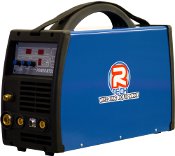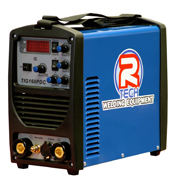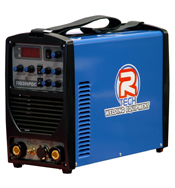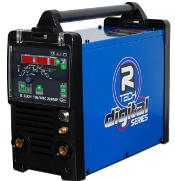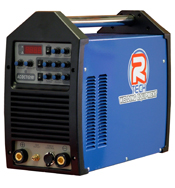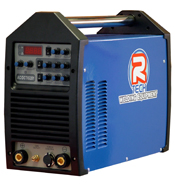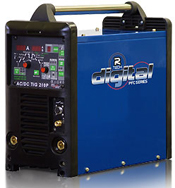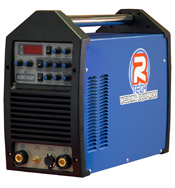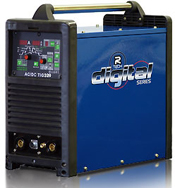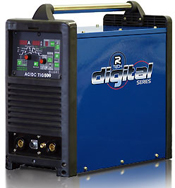|
What is TIG
Welding?
With TIG Welding the
welder needs to use two hands to weld. With the one hand the torch is held and with the other hand
is there to hold the filler metal to the joint you want to weld. TIG welding is different to other
types of welding because of the way the arc is created and how the filler metal is added. TIG is
the most difficult type of welding to learn, yet at the same time it gives one the most options
when it comes to different metals. The process is slow but it produces the highest quality weld.
TIG welding is popular for critical weld joints, welding metals besides steel, and where
precise small welds are
required.
If one is considering getting a job as a TIG welder, it is
important to know the different names and abbreviations for TIG welding. The name TIG actually
stands for Tungsten Inert Gas Welding. The American Welding Society calls it GTAW, which stands for
Gas Tungsten Arc Welding. GTAW is an abbreviation that welding engineers use to specify the welding
process on plans.
TIG welding was introduced in the 1940's and Helium gas was
the primary gas used in the process, and today is a registered trademark, 'Genuine Heliarc' and is
owned by ESAB welding equipment. The older generation still use the term Heliarc for TIG
welding.
Why Use Tungsten to Weld
Tungsten makes TIG
welding possible. Tungsten is a very hard slightly radioactive, and brittle metal, it's uses are
limited compared to other metals. The tungsten is made into a non consumable electrode that is used
to create the arc for TIG welding. Other uses for tungsten are light bulbs, heating elements, and
rocket engines. Any place that requires a very high melting point or the need to pass electricity
at a high temperature. In TIG welding the tungsten metal properties allows the arc to maintain a
temperature of over 6,000 degrees Celsius. As it has a
high melting point it prevents the electrode from burning up. The unique properties of tungsten
allow welding with a hotter arc than the actual melting point of tungsten. The tensile strength of
tungsten is very high of up to 226,796 kgs per sq cm. Comparing with steel, tungsten is very
strong! Although it is strong it is very brittle, even a tap of a hammer will break a tungsten
electrode.
How TIG Welding Works
For a TIG welder to work it requires three things, filler
metal, heat and shielding.
· The filler metal
is wire that is added to the heat of the torch
arc and melted.
·
Heat is produced when electricity passes through the tungsten
electrode and creating an arc to the metal.
·
Shielding comes from a compressed bottle of gas
that flows to the weld area to protect it from air.
It is very simple how these three come together. The welder turns on
the gas flow, the gas begins to flow and protects the weld area from the air. The torch is held
over where you want to weld and far enough for the torch not to touch the metal. The welder then
either presses a button or a foot pedal and the tungsten electrode in the TIG torch starts an arc.
Once the arc begins the two pieces of metal begin to melt by creating a puddle of metal. Once there
is a puddle, the welder starts filling the joint manually by dipping welding wire into the arc to
fill the joint. Eventually the process creates a single piece of metal.
TIG Power Supplies
TIG welders usually have inverters for their power supplies. The
power supply is a constant amperage power supplies. They keep the amperage consistent and the heat
settings are regulated in amperage. The voltage on these power supplies will vary depending on the
length of the arc.
Today many welders come from China, although they are relatively
inexpensive, most of them are not of good quality. If TIG Welder has a Mosfet power module, the
quality will not be good. If it has a Siemens IGBT power module, it should be a good quality
welder. TIG welders normally mention power cycles. For example 60% Power Cycle. This means for
every 10 minutes of welding one can weld for 6 minutes, unfortunately in China there are no
standards, so you have no guarantee that the TIG welder has a genuine 60% power
cycle
TIG Power supplies normally come with a high frequency start. This
stops the need to physical strike on the arc. Once the TIG torch is activated the high frequency
start feature can literally create an arc across one inch gap between the TIG torch and the metal.
This is done by creating high voltage that has the pressure required to jump the distance. Once the
arc is established the voltage drops and the amperage goes to what the machine is set at. The
frequency start feature helps the tungsten electrode breaking up.
Other features of the power supply are frequency settings. There are
many ways to help the welding arc run smother. A frequency range or pulses of electricity are used
to achieve the desired arc type. The biggest benefit is they give the arc a cleaning
characteristic. These settings are normally used when welding aluminium or
magnesium.
TIG Torch Types
There are two options for a TIG torch. The first is an air
cooled torch, which is inexpensive, however it does heat up very quickly. The second is the water
cooled torch, but this requires a water cooler. If using a water cooler, distilled water should be
used, so as to ensure no impurities clog up the cable and machine.
TIG Welding Machine Set-Up
When setting up a TIG welder there are two main settings.
They are amperage and gas flow. Amperage settings vary depending on the type and thickness of the
metal to be welded. Gas flow rates also vary depending on draft conditions, cup size, and sometimes
the position of the weld. The gas flow rate could range from 5 CFH to 60 CFH for a large cup and
drafty conditions. When choosing the gas to weld it is almost always assumed that you will be using
pure Argon.
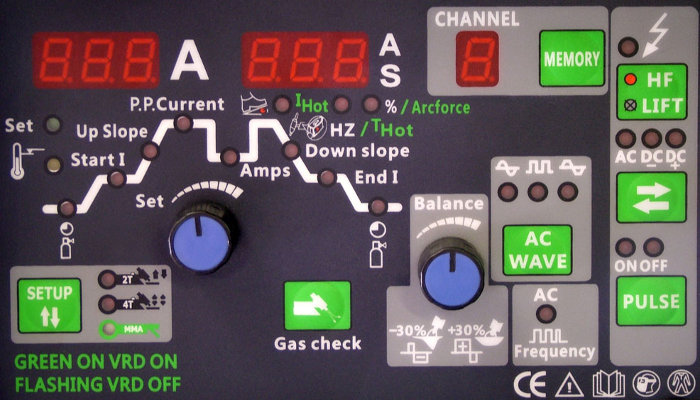
Some basic guidlines for machine set-up are as
follows:
1.6mm
Tungsten - Require an amperage range
between 50 to 100 amps. The recommended cup size are 4,5, or 6. Gas flow rate should be
between 5 to 15CFH.
2.4mm Tungsten - Require an amperage range between 80 to 130 amps. The recommended cup
size are 6, 7, or 8. Gas flow rate should be between 8 to 20 CFH.
3.2mm Tungsten - Require an amperage range between 90 to 250 amps. The recommended cup
size are 6, 7, or 8. Gas flow rate should be between 8 to 25 CFH.
· Tig Welding Steel
Tig welding steel is very easy.
For welding steel and stainless steel the
Tungsten needs to be shaped to a fine point.
TIG Welding Stainless Steel
Stainless steel welds almost like steel. It does not take a
lot of extra practice, uses the same type of tungsten, and Argon gas. The one exception is that
welding stainless steel requires good gas coverage. Stainless steel sometimes requires the weld to
be submerged in an Argon bath or if it is an open root weld the inside of the joint must be purged
with a filler gas.
One of the problems of welding stainless steel is it has a
tendency to warp if too much heat is applied or the pieces welded are not braced properly! be
absolutely free of anything except clean stainless steel. If this is not done you will find the
filler wire will not flow into the joint. When welding on a less then clean stainless steel joint
you will find the filler wire won’t want to stick to many parts of the
joint.
TIG Welding Aluminium
When TIG Welding aluminium there are a few steps needed to
setup for it. First is the tungsten! The tungsten needs to be either pure Tungsten or Zirconium
Tungsten. The tungsten also needs a ball shape at the end of it to spread the heat properly. The
second is the current type and that is aluminium always welds with A/C (alternating current).
Welding aluminium always requires a high frequency start from either a high production button or a
foot pedal operated TIG torch. The main difference when welding aluminium verses other metals is
how the puddle looks. Aluminium just has a shiny puddle that does not glow. It looks like tinfoil
moving. When welding aluminium overheating of the metal must be avoided. It’s real easy to keep
welding and all of a sudden the whole weld area just drops to the floor.
TIG
Welding Anodized Aluminium
When TIG welding smaller diameter aluminium tubing many
people like to use a high production button. The purpose for the button is to bump the weld. What
that means is basically spot welding around the pipe or tubing. This technique is typically used to
weld anodized aluminium pipe. In the yacht industry many boats have tuna or marlin towers installed
before they are sold. These towers are made of brushed or anodized aluminium to keep the pipe
protected from the salt water. The anodized pipe has a coating that makes it very difficult to
weld. Welding anodized aluminium requires two steps. The first step is to spot weld around the pipe
and add filler wire. This weld is less then acceptable looking because the anodized coating has not
melted properly. The second step is to spot or bump weld around the same weld without adding filler
wire. What this does is melt the anodized coating into the weld better. After that the weld is
painted with weld paint to protect it.
TIG Welding Exotic Metals and
Alloys
TIG can weld almost any metal. This is possible because the
main gasses used are noble inert gasses and their properties do not alter the weld properties. Most
other welding processes use some type of flux or chemical additives to the filler metal. With TIG
welding it is pure heat that creates the weld joint and that allows any metal that can be melted to
be joined as long as the filler wire is compatible. Some of the exotic metals that are commonly
welded are:
Copper Nickel “CUNI” and Copper Nickel
Alloys
Many people who weld CUNI say it has a muddy feel to it.
That is only true if you use too much heat and in that case the metal will turn very dark. When
done right the weld will look very close to stainless steel with almost the same copper colour to
it. The best way to describe the feel and look of the puddle is a combination between stainless
steel and aluminium. The puddle acts like stainless steel but is more fluid with a hint of shine or
tin feel like welding aluminium. The catch with welding copper nickel and copper nickel alloys is
that cold lap and roll are a common problem. Many time the weld looks like it has penetrated
properly but in some places it is actually lacking penetration. It is very hard to detect cold roll
and lap with copper nickel unless a die penetration test is done.
Magnesium
Magnesium is typically welded with pure Argon gas. The type
of tungsten used is typically Zirconiated tungsten with an AWS designation of EWZr. In most cases
the current will be A/C (alternating current) requiring a high frequency
start.
Titanium
Welding titanium uses Argon gas and many times requires an
Argon bath to be welded in. In many cases the gas coverage that the TIG torch gives is not enough.
Titanium can be welded using 2% Thorium Tungsten with an AWS classification of EWPTh-2 and with
DCEN (direct current electrode negative).
TIG Welding of Dissimilar
Metals
One of the less common welding practices is welding of
dissimilar metals. TIG welding has a lot of options when it comes to welding dissimilar metals.
Most of these options depend on the design of the filler wire. In a few cases there are two steps
to welding dissimilar metals but in the end theses metals can be joined. Some of the combinations
of dissimilar metals that can be TIG welded are:
· Copper to Everdur
· Copper Nickel to Everdur
· Copper and Everdur to Steel
· Copper to Stainless Steel
· Hastelloy Alloy C to Steel
· Nickel to Steel
· Stainless Steel to Cast Iron
· Stainless Steel to Inconel
· Stainless Steel to Low Alloy or Carbon
Steel
|

